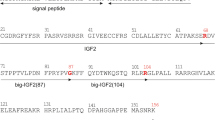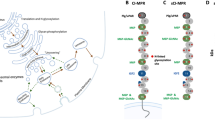Abstract
Human insulin–like growth factor I (IGF–I) accumulates in both folded and aggregated forms in the fermentation medium and cellular periplasmic space when expressed in E. coli with an endogenous secretory signal sequence. Due to its heterogeneity in form and location, low yield of IGF–I was obtained using a typical refractile body recovery strategy. To enhance recovery yield, a new procedure was developed to solubilize and extract IGF–I from cells while in fermentation broth. This method, called in situ solubilization, involves addition of chaotrope and reductant to alkaline fermentation broth and provides recovery of about 90% of all IGF–I in an isolated supernatant. To further enhance recovery, a new aqueous two–phase extraction procedure was developed which partitions soluble non–native IGF–I and biomass solids into separate liquid phases. This two–phase extraction procedure involves addition of polymer and salt to the solubilization mixture and provides about 90% recovery of solubilized IGF–I in the light phase. The performance of the solubilization and aqueous extraction procedures is reproducible at scales ranging from 10 to 1000 liters and provides a 70% cumulative recovery yield of IGF–I in the isolated light phase. The procedure provides significant initial IGF–I purification since most host proteins remain cell associated during solubilization and are enriched in heavy phase. ELISA analysis for E. coli proteins indicates that 97% of the protein in the light phase is IGF–I. Together, the techniques of in situ solubilization and aqueous two–phase extraction provide a new, high yield approach for isolating recombinant protein which is accumulated in more than one form during fermentation.
This is a preview of subscription content, access via your institution
Access options
Subscribe to this journal
Receive 12 print issues and online access
$259.00 per year
only $21.58 per issue
Buy this article
- Purchase on SpringerLink
- Instant access to full article PDF
Prices may be subject to local taxes which are calculated during checkout
Similar content being viewed by others
References
Wilkinson, D.L. and Harrison, R.G. 1991. Predicting the solubility of recombinant proteins in Escherichia coli. Bio/Technology 9: 443–448.
Mitraki, A. and King, J. 1989. Protein folding intermediates and inclusion body formation. Bio/Technology 7: 690–697.
Kiefhaber, T., Rudolph, R., Kohler, H.-H. and Buchner, J. 1991. Protein aggregation in vitro and in vivo: a quantitative model of the kinetic competition between folding and aggregation. Bio/Technology 9: 825–829.
Kane, J.F. and Hartley, D.L. 1988. Formation of recombinant protein inclusion bodies in Escherichia coli. TIBTECH 6: 95–101.
Schein, C.H. 1989. Production of soluble recombinant proteins in bacteria. Bio/Technology 7: 1141–1149.
Schein, C.H. and Noteborn, M.H.M. 1988. Formation of soluble recombinant proteins in Escherichia coli is favored by lower growth temperature. Bio/Technology 6: 291–294.
Kopetzki, E., Schumacher, G. and Buckel, P. 1989. Control of formation of active soluble or inactive insoluble bakers yeast alpha-glucosidase PI in Escherichia coli by induction and growth conditions. Mol. Gen. Genet. 216: 149–155.
Strandberg, L. and Enfors, S. 1991. Factors influencing inclusion body formation in the production of a fused protein in Escherichia coli. Appl. Environ. Microb. 57: 1669–1674.
Gardiner, S.A.M., Olbrich, R., Marston, F.A.O., Fish, N.M. and Hoare, M. 1987. Process design for recombinant protein recovery from inclusion bodies, p. 541–544. In: Proc. 4th European Congress on Biotechnology, Vol. 2. Neijssel, O. M., van der Meer, R. R. and Luyben, K. C. A. M. (Eds.). Elsevier Science Publishers B. V., Amsterdam, Netherlands.
Fish, N.M. and Hoare, M. 1988. Recovery of protein inclusion bodies. Bio-chem. Soc. Trans. 16: 102–104.
Taylor, G., Hoare, M., Gray, D.R. and Marston, F.A.O. 1986. Size and density of protein inclusion bodies. Bio/Technology 4: 553–557.
Bowden, G.A., Paredes, A.M. and Georgiou, G. 1991. Structure and morphology of protein inclusion bodies in Escherichia coli. Bio/Technology 9: 725–730.
Marston, F.A.O. and Hartley, D.L. 1990. Solubilization of protein aggregates. Meth. Enzym. 182: 264–276.
Hart, R.A., Ogez, J.R. and Builder, S.E. 1994. Aqueous two-phase systems for isolation of non-native IGF-I. Submitted to Bioseparations
Hettwer, D. and Wang, H. 1989. Protein release from Escherichia coli cells permeabilized with guanidine-HC1 and Triton X-100. Biotech. Bioeng. 33: 886–895.
Harrison, S.T.L., Dennis, J.S. and Chase, H.A. 1991. Combined chemical and mechanical processes for the disruption of bacteria. Bioseparation 2: 95–105.
Kula, M., Kroner, K.H. and Hustedt, H. 1982. Purification of enzymes by liquid-liquid extraction. Adv. Biochem. Eng. 24: 73–118.
Langley, K.E., Berg, T.F., Strickland, T.W., Fenton, D.M., Boone, T.C. and Wypych, J. 1987. Recombinant-DNA-derived bovine growth hormone from Escherichia coli. Eur. J. Biochem. 163: 313–321.
Marston, F.A.O., Lowe, P.A., Doel, M.T., Schoemaker, J.M., White, S. and Angal, S. 1984. Purification of calf prochymosin (prorennin) synthesized in Escherichia coli. Bio/Technology 2: 800–804.
Schoner, R.G., Ellis, L.F. and Schoner, B.E. 1985. Isolation and purification of protein granules from Escherichia coli cells overproducing bovine growth hormone. Bio/Technology 3: 151–154.
Hart, R.A., Rinas, U. and Bailey, J.E. 1990. Protein composition of Vitreos-cilla hemoglobin inclusion bodies produced in Escherichia coli. J. Biol. Chem. 265: 12728–12733.
Veeraragavan, K. 1989. Studies on two major contaminating proteins of the cytoplasmic inclusion bodies in Escherichia coli. FEMS Microb. Lett. 61: 149–152.
Schnaitman, C.A. 1971. Effect of ethylenediaminetetraacetic acid, triton X-100, and lysozyme on the morphology and chemical composition of isolated cell walls of Escherichia coli. J. Bact. 108: 553–563.
Babbitt, P.C., West, B.L., Buechter, D.D., Kuntz, I.D. and Kenyon, G.L. 1990. Removal of a proteolytic activity associated with aggregates formed from expression of creatine kinase in Escherichia coli leads to improved recovery of active enzyme. Bio/Technology 8: 945–949.
Cole, K.D. 1991. Purification of plasmid and high molecular mass DNA using PEG-salt two-phase extraction. Bio/Techniques 11: 18–24.
Axelsson, H.A.C. 1985. Centrifugation, p. 325–346. In: Comprehensive Biotechnology. Cooney, C. L. and Humphrey, A. E. (Eds.). Pergamon Press, New York, NY.
Kula, M. 1985. Liquid-liquid extraction of biopolymers, p. 451–471. In: Comprehensive Biotechnology, Vol 2. Cooney, C. L. and Humphrey, A. E. (Eds.). Pergamon Press, New York, NY.
Hart, R.A., Lester, P.M., Reifsnyder, D.H., Ogez, J.R. and Builder, S.E. 1994. Effect of environment on IGF-I refolding selectivity. Biotechnol. Appl. Biochem. In press.
Cleland, J.L., Builder, S.E., Swartz, J.R., Winkler, M., Chang, J.Y. and Wand, D.I.C. 1992. Polyethylene glycol enhanced protein refolding. Bio/Technology 10: 1013–1019.
Cleland, J.L. and Randolph, T.W. 1992. Mechanism of polyethylene glycol interaction with the molten globule folding intermediate of bovine carbonic anhydrase B. J. Biol. Chem. 267: 3147–3153.
Spolar, R.S., Ha, J.-H. and Record, M.T. 1989. Hydrophobic effect in protein folding and other noncovalent processes involving proteins. Proc. Natl. Acad. Sci. USA 86: 8382–8385.
Eiteman, M.A. and Gainer, J.L. 1990. Peptide hydrophobicity and partitioning in poly (ethylene glycol)/magnesium sulfate aqueous two-phase systems. Biotechnol. Prog. 6: 479–484.
Diamond, A.D., Yu, K. and Hsu, J.T. 1990. Peptide and protein partitioning in aqueous two-phase systems, p. 52–65. In: Protein Purification: From Molecular Mechanisms to Large Scale Processes. Ladisch, M. R., Wilson, R. C., Paiton, C. C. and Builder, S. E. (Eds.). A. C. S. Symposium Series, American Chemical Society, Washington, DC.
Cole, K.D. 1992. Salt-PEG two-phase aqueous systems to purify proteins and nucleic acid mixtures, p. 340–351. In: Frontiers in Bioprocessing II. Todd, P., Sikdar, S. K. and Bier, M. (Eds.). A. C. S. Symposium Series, American Chemical Society, Washington, DC.
Bozzola, J.J. and Russell, L.D. 1992. Electron Microscopy, Principles and Techniques for Biologists. Jones and Bartlett, Boston, MA.
Chang, J.Y., McFarland, N.C. and Swartz, J.R. 1994. Method for refolding insoluble, misfolded insulin-like growth factor-I into an active conformation. U. S. Patent 5,288,931.
Author information
Authors and Affiliations
Rights and permissions
About this article
Cite this article
Hart, R., Lester, P., Reifsnyder, D. et al. Large Scale, In Situ Isolation of Periplasmic IGF–I from E. coli. Nat Biotechnol 12, 1113–1117 (1994). https://doi.org/10.1038/nbt1194-1113
Received:
Accepted:
Issue date:
DOI: https://doi.org/10.1038/nbt1194-1113
This article is cited by
-
PEG–salt aqueous two-phase systems: an attractive and versatile liquid–liquid extraction technology for the downstream processing of proteins and enzymes
Applied Microbiology and Biotechnology (2015)
-
How to find soluble proteins: a comprehensive analysis of alpha/beta hydrolases for recombinant expression in E. coli
BMC Genomics (2005)
-
Affinity-assisted in vivo folding of a secreted human peptide hormone in Escherichia Coli
Nature Biotechnology (1996)



